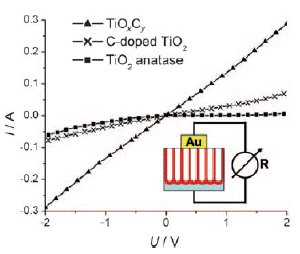Home > Press > Conducting Tubes
 |
Abstract:
Carbonized titanium dioxide nanotubes with semimetallic properties increase the efficiency of methanol fuel cells
Conducting Tubes
Germany & Finland | Posted on September 8th, 2009Mention of nanotubes usually means carbon nanotubes. But not all tiny tubes are made of carbon. For example, layers made of nanoscopic titanium dioxide have proven to be useful materials for biotechnology, catalytic converters, and solar cell technology. Although the semiconducting properties of these nanotubes are critical for many of these applications, their limited conductivity represents a hindrance for other areas of application. A team at the University of Erlangen-Nürnberg and the University of Turku in Finland has now found an easy way to breathe some metal-like conductivity into the nanotubes without changing their structure. Through carbonization, the titanium dioxide can be converted into a carbon-containing titanium oxycarbide compound. As the researchers led by Patrik Schmuki report in the journal Angewandte Chemie, this novel material could drastically increase theefficiency of methanol fuel cells.
In order to carbonize titanium dioxide nanotubes, the researchers treated them with acetylene at 850 °C. This forms a carbon-rich compound with semimetallic properties, which is also significantly harder than before carbonization. "This is not about simply doping titanium dioxide with carbon atoms," clarifies Schmuki. "Although the ordered tube structures remain almost completely unchanged, a new chemical compound is formed. This titanium oxycarbide can be interpreted as a solid mixture of titanium carbide and various titanium oxides." Its high electrical conductivity and favorable electrochemical characteristics make this new material an interesting new electrode material.
Its use in methanol fuel cells seems particularly attractive. These days, methanol oxidation is usually carried out at catalytic electrodes with a carbon support and a platinum or ruthenium catalyst. "Titanium dioxide nanotubes have been under consideration as an alternative to the carbon support for a number of years," says Schmuki. "But our new conducting oxycarbide beats these by a mile: Supports made of the oxycarbide increase the activity of the catalyst for the methanol oxidation by 700 %."
More information: Patrik Schmuki, Semimetallic TiO2 Nanotubes, Angewandte Chemie International Edition 2009, 48, No. 39, 7236-7239, doi: 10.1002/anie.200902207
Author: Patrik Schmuki, Carbonisierte
Titandioxidnanoröhrchen mit halbmetallischen
Eigenschaften steigern die Leistung von
Methanol-Brennstoffzellen,
www.lko.uni-erlangen.de/En/Frames/overview-frame.html
####
About Wiley InterScience
Wiley InterScience (www.interscience.wiley.com) provides access to over 3 million articles across nearly 1500 journals and 7000 Online Books and major reference works. It also holds industry leading databases such as The Cochrane Library, chemistry databases and the acclaimed Current Protocols laboratory manuals.
For more information, please click here
Contacts:
Contact: Editorial office:
or Amy Molnar (US):
or
Jennifer Beal (UK):
or
Alina Boey (Asia)
Copyright © Wiley InterScience
If you have a comment, please Contact us.Issuers of news releases, not 7th Wave, Inc. or Nanotechnology Now, are solely responsible for the accuracy of the content.
| Related News Press |
News and information
![]() Researchers develop molecular qubits that communicate at telecom frequencies October 3rd, 2025
Researchers develop molecular qubits that communicate at telecom frequencies October 3rd, 2025
![]() Next-generation quantum communication October 3rd, 2025
Next-generation quantum communication October 3rd, 2025
![]() "Nanoreactor" cage uses visible light for catalytic and ultra-selective cross-cycloadditions October 3rd, 2025
"Nanoreactor" cage uses visible light for catalytic and ultra-selective cross-cycloadditions October 3rd, 2025
Nanotubes/Buckyballs/Fullerenes/Nanorods/Nanostrings
![]() Enhancing power factor of p- and n-type single-walled carbon nanotubes April 25th, 2025
Enhancing power factor of p- and n-type single-walled carbon nanotubes April 25th, 2025
![]() Chainmail-like material could be the future of armor: First 2D mechanically interlocked polymer exhibits exceptional flexibility and strength January 17th, 2025
Chainmail-like material could be the future of armor: First 2D mechanically interlocked polymer exhibits exceptional flexibility and strength January 17th, 2025
![]() Innovative biomimetic superhydrophobic coating combines repair and buffering properties for superior anti-erosion December 13th, 2024
Innovative biomimetic superhydrophobic coating combines repair and buffering properties for superior anti-erosion December 13th, 2024
Announcements
![]() Rice membrane extracts lithium from brines with greater speed, less waste October 3rd, 2025
Rice membrane extracts lithium from brines with greater speed, less waste October 3rd, 2025
![]() Researchers develop molecular qubits that communicate at telecom frequencies October 3rd, 2025
Researchers develop molecular qubits that communicate at telecom frequencies October 3rd, 2025
![]() Next-generation quantum communication October 3rd, 2025
Next-generation quantum communication October 3rd, 2025
![]() "Nanoreactor" cage uses visible light for catalytic and ultra-selective cross-cycloadditions October 3rd, 2025
"Nanoreactor" cage uses visible light for catalytic and ultra-selective cross-cycloadditions October 3rd, 2025
Energy
![]() Sensors innovations for smart lithium-based batteries: advancements, opportunities, and potential challenges August 8th, 2025
Sensors innovations for smart lithium-based batteries: advancements, opportunities, and potential challenges August 8th, 2025
![]() Simple algorithm paired with standard imaging tool could predict failure in lithium metal batteries August 8th, 2025
Simple algorithm paired with standard imaging tool could predict failure in lithium metal batteries August 8th, 2025
Fuel Cells
![]() Deciphering local microstrain-induced optimization of asymmetric Fe single atomic sites for efficient oxygen reduction August 8th, 2025
Deciphering local microstrain-induced optimization of asymmetric Fe single atomic sites for efficient oxygen reduction August 8th, 2025
![]() Current and Future Developments in Nanomaterials and Carbon Nanotubes: Applications of Nanomaterials in Energy Storage and Electronics October 28th, 2022
Current and Future Developments in Nanomaterials and Carbon Nanotubes: Applications of Nanomaterials in Energy Storage and Electronics October 28th, 2022
|
|
||
|
|
||
| The latest news from around the world, FREE | ||
|
|
||
|
|
||
| Premium Products | ||
|
|
||
|
Only the news you want to read!
Learn More |
||
|
|
||
|
Full-service, expert consulting
Learn More |
||
|
|
||








